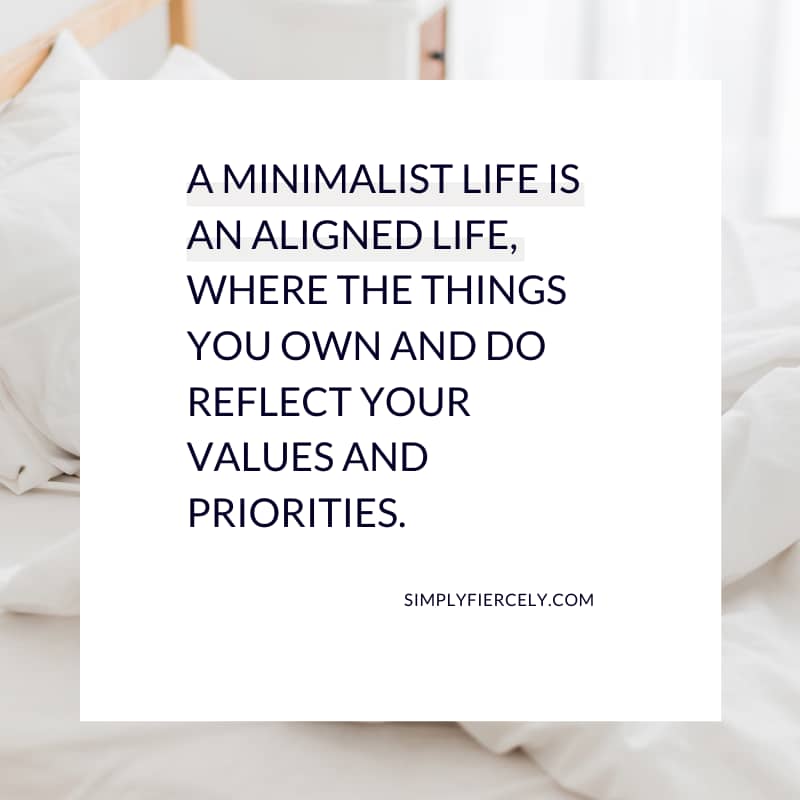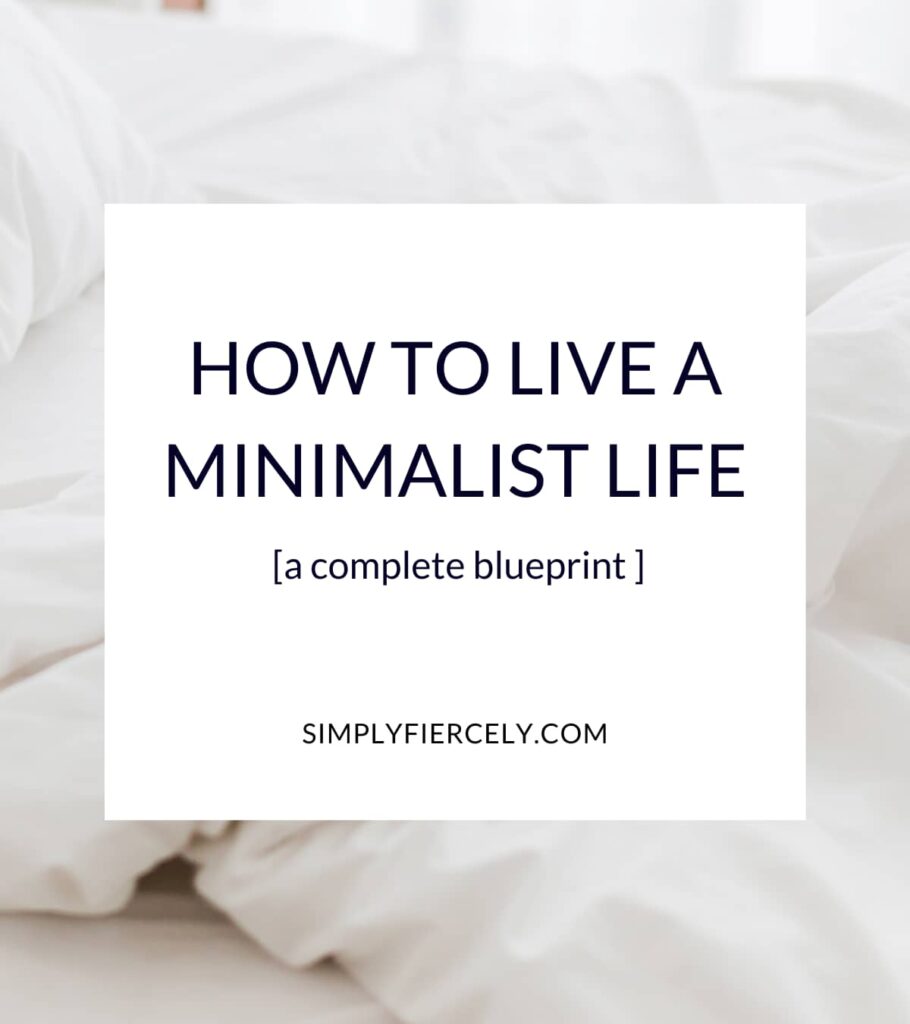If you’ve ever wondered how to live minimally, then you’re not alone. People everywhere have had enough of feeling busy, cluttered and overwhelmed.
They want to take back their homes, their schedules, their money—and quite frankly, their lives. They’re craving space to breathe, to grow, and to love. (This is why Marie Kondo is becoming so popular!).
It’s a desire that weighs heavily on the hearts of many, especially in this challenging season of life. You can almost feel a collective desire to slow down and create space for things that truly matter.
This explains the growing interest in the minimalist lifestyle—but does living with less really deliver on the promise of simplicity? And if so, how does one even begin to untangle the complicated web of clutter in our lives?
Keep reading to find out.
What Does It Mean to Live a Minimalist Life?
If you’re new to minimalist living, you might be wondering just how much you have to give up to reap the benefits of a decluttered life. You want to simplify, but you’re worried about depriving your family or perhaps feeling pressure to let go of cherished heirlooms.
If so, I want you to know that minimalism is not a contest to see who can live with the least amount of household items. Instead, a minimalist life is an aligned life, where the things you own and do reflect your values and priorities. You don’t need to live in open spaces. You can experience minimal living while in a tiny apartment.
It’s not about deprivation. Instead, it’s about enoughness.
For some, this means big sweeping changes and trucking carloads of “stuff” to your local charity shop—but for others, it’s a subtle shift. A simple “no, thank you” to an invitation or letting go of a well-loved (but never worn) sweater.
A minimalist life is not a destination or a finish line to cross. Instead, it’s an intentional way of decision-making, where we consider the tradeoffs before sacrificing our precious time and energy. You don’t have to get rid of sentimental items, but you will get rid of emotional clutter.
Why Choose a Minimalist Life?
We make these careful decisions for one simple reason: to create space. How you use that space is then up to you.
Here are just a few reasons why people choose a minimalist life:
- Space in your budget: Owning less saves money, which means you could retire earlier or become debt-free.
- Space on your calendar: Declutter your schedule and reclaim your time so that you can do more of the things that matter.
- Space in your home: A decluttered home is a delight to live in. It fills your cup instead of draining your energy.
- Space in your mind: With less stress and fewer responsibilities, minimalism delivers the joy of a quiet mind.
This is just a sample of the many benefits of minimalism – there are so many more!
Personally, I was motivated by a desire for more freedom in my life. I wasn’t sure exactly what that would look like at first, but I did know that I was tired of feeling suffocated.
Too much stuff, too much to do, too much stress, too many worries … it was weighing me down and crushing my spirit. I chose a minimalist life because I wanted to breathe without the weight of the world on my shoulders.
I needed space to try new things, to make mistakes, and to reconnect with my authentic self. Minimalism has delivered on all of these gifts and so much more.

7 Ways You Can Live a Minimalist Life
If you are craving a life with fewer things and more freedom, then here are seven things you can do to start simple living.
1. Define your priorities
As I’ve already mentioned, minimalism is about alignment. If you want more of what matters most, then you need to start by defining what matters most. Writing down your values is an easy way to make harder decisions later on.
Don’t skip this step or assume that you know your priorities. The clutter in your life is proof that you probably don’t—but please don’t feel bad about this.
The world where we live is full of noise: the expectations of our friends and family, the images we see on TV, and even the stories we tell ourselves. I wish we could turn it all off, but perhaps more realistically, we need to learn to navigate the waters.
We can do this by clarifying what matters and increasing our focus. The more you know what’s important to you, the easier it is to tune out or let go of the things that aren’t.
2. Let go of external expectations
Much of the clutter in our lives comes from our expectations. There are so many things that we want to do and be, and when the pressure gets too much, we look outwards to fill the void. A great way to put minimalism into practice in your everyday life is to take care of your mental health. Let go of the pressure to make everyone else happy.
A career that doesn’t live up to other people’s standards? Don’t worry—just work long hours and buy a designer handbag to feel validated.
Mum guilt after long hours at the office? It’s OK—a playroom full of the latest toys will help you feel like the mother you want to be (even when your inner voice claims that you’re hopelessly failing).
Enough already.
When we let go expectations and stop comparing ourselves to others, the hole in our lives that we’re desperately trying to fill goes away. The need for “more” gives way to whole-hearted feelings of joy and gratitude instead.
How do you do this? The first step is to understand happiness on your own terms. What are your values? Then, worry about making yourself happy. This might mean posting less often on social media. It might mean making your circle of trust smaller. But in order to live a simpler life, you have to worry less about what others think of you.
Related Post: How to Be Happy With What You Have + Stop Wanting More
3. Declutter your home
As you create clarity about the life you want, decluttering your home is the natural next step.
The things that don’t serve you will start to feel uncomfortable. It’s like wearing shoes that have already moulded to some else’s foot—you can make yourself wear them, but something feels off. You know that they’re not meant for you, and neither is your cluttered home.
If you’ve arrived at this stage in your journey and you’re struggling to let go, then I invite you to download my free Mindful Decluttering guide and workbook.
Simply enter your details below for instant access (and as a bonus, you’ll also get regular newsletters where I share personal stories, inspiration, and special offers).
4. Take back your time
One of the beautiful things about living a more minimalist lifestyle is that the skills you learn from decluttering your home can then be applied to other areas of your life—like your to-do list and your schedule.
Start looking critically at your commitments and responsibilities, and ask hard questions. Are you acting in alignment with your values and priorities? Or are taking on unnecessary jobs out of guilt, obligation, or fear? (And if so, how much of those heavy feelings are self-imposed?)
It probably won’t happen overnight, but little by little, you can declutter your schedule, be less busy, and take back your free time.
5. Stop mindless spending
You wouldn’t attempt to fix a leaking pipe without turning off the water first. In the same way, you can’t declutter your life without addressing your shopping habits. This step is good for your credit cards, bank account, and your physical space.
And yet again, it’s about alignment. What motivates you to buy new things? Are you shopping to fill a genuine need? Or is it a way of buffering complicated feelings, such as grief or self-doubt?
When you create awareness about why you shop, you empower yourself to make mindful, values-led decisions about your spending.
One of the best ways to do this is to create a capsule wardrobe that you can wear without worrying about trends. When you have a minimalist mindset, you’ll care more about putting together outfits with what you have than chasing after fast fashion.
Related Post: 4 Reasons Why You Can’t Stop Shopping + What To Do About It
6. Embrace intentional living
The clutter in our lives is often a by-product of passive living. We make choices about what to buy, own, or do, and we act out of habit instead of intent. Too often, we live on auto-pilot without even realising that we’ve given up control.
The solution is simple: start by asking “why”.
- Why are you going into Target?
- Why are you working late?
- Why are you staying up and not resting?
- Why are you keeping that dress?
It’s not about passing judgement or chasing perfection. Instead, intentional living is about creating awareness and understanding. As we learn more about how we move through the world, our eyes open to ways of simplifying that we may not have seen in the past.
The minimalist home is one where you think about what you do before you do it. It’s a way of life that you can control – and you do this by changing your daily habits so that you do them on purpose. You see, minimalism isn’t always about less stuff or less clutter. It is also about clearing your mind of mental clutter too.
7. Practice self-compassion
How much time do you spend criticizing yourself? Way too often, a lot of people hold themselves back simply by being too hard on themselves. That’s why the most important (yet often overlooked) element of a minimalist life is self-compassion.
Decluttering in all forms involves acknowledging mistakes. At some stage, we invited things into our lives that don’t belong, and now we have to do the humbling work of letting go.
It’s messy, and you’ll undoubtedly come up against feelings like guilt, shame, regret, and self-doubt. When this happens, you’ve got two choices.
You can shove your clutter back in your closet and pretend those feelings don’t exist … or you can move forward with grace and self-compassion. It’s not an easy road, but in my experience, it’s the path worth taking.
Related Post: How to Stop Comparing Yourself To Others
My Life As a Minimalist
This roadmap to a minimalist life is a reflection of my personal journey. A decade ago, I was a shopaholic, working 60+ hours a week and crumbling under the pressure. I felt hopeless and trapped in my life.
Then one day, a blog post opened my eyes to a simpler way of living—and since then, I’ve been stumbling my way down this new road. There’s been a lot of learning (or more often, unlearning) but slowly and steadily, my entire life has changed.
If you’re interested in learning more about my story, here are a few blog posts you might enjoy:
If you’d like to learn more about living a minimalist life, then I invite you to explore one of my online courses.
What does minimalism mean to you? Do you have any tips on how to live a minimalist life? Let us know in the comments! X

